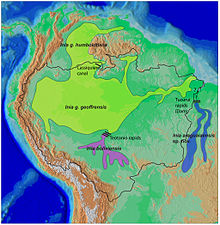Araguaian river dolphin
| Araguaian river dolphin | |
|---|---|
 |
|
| Cranium and mandible of holotype (ruler is 10 cm long) | |
| Scientific classification | |
| Kingdom: | Animalia |
| Phylum: | Chordata |
| Class: | Mammalia |
| Order: | Artiodactyla |
| Infraorder: | Cetacea |
| Family: | Iniidae |
| Genus: | Inia |
| Species: | I. araguaiaensis |
| Binomial name | |
|
Inia araguaiaensis Hrbek, Da Silva, Dutra, Farias, 2014 |
|
 |
|
| Inia spp. ranges. I. araguaiaensis is in blue at right; I. geoffrensis and I. boliviensis are light green and purple, respectively. | |
The Araguaian river dolphin or Araguaian boto (Inia araguaiaensis) is a South American river dolphin population whose identification as a species distinct from the Amazon river dolphin (Inia geoffrensis) was announced in 2014. It is native to the Araguaia– basin of Brazil.
As of October 2014, I. araguaiaensis is not recognized as a separate species by the Society for Marine Mammalogy. Their Committee on Taxonomy made these comments regarding the decision to not include I. araguaiaensis as an independent species: "Inia araguaiaensis, was described by Hrbek et al. (2014). However, this study only examined samples from two extremes of the distribution of Inia so is it unclear if the molecular differences observed represented real species-level separation or were due to sampling from two locations separated by a large distance. Diagnostic osteological differences were also reported. However, because this was based on the examination of very few specimens (only 2 for the new species and only 9 for I. geoffrensis), the authors’ conclusions are very concerning."
The recognition of I. araguaiaensis as a separate species was announced on January 22, 2014. It was distinguished from other members of Inia on the basis of nuclear microsatellite and data as well as differences in skull morphology (it generally has a wider skull). It also differs from the Amazon and Bolivian river dolphins in the number of teeth per hemimandible (24–28 versus 25–29 and 31–35, respectively). It is the first new river dolphin species to be described since 1918.
Members of the genus are gray to pink in color and have a body length range from 1.53 to 2.6 m (5.0 to 8.5 ft). They have a dorsal ridge rather than a fin. Their neck vertebrae are unfused, allowing them to turn their heads sharply. Like other river dolphins, I. araguaiaensis has a prominent forehead and a much longer snout than those of most marine dolphins, as well as smaller eyes than marine dolphins. Because their aquatic environment is often turbid, their vision is not as well developed. River dolphins tend to be less active than marine dolphins. They feed mainly on fish, aided by echolocation.
...
Wikipedia
